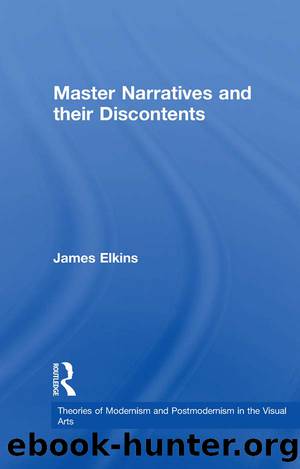Master Narratives and Their Discontents by Elkins James;

Author:Elkins, James;
Language: eng
Format: epub
ISBN: 1487199
Publisher: Taylor & Francis Group
_________________
1.
A good introduction to literary and philosophic theories of postmodernism is Matei Calinescu, âIntroductory Remarks: Postmodernism, the Mimetic and Theatrical Faces,â in Exploring Postmodernism, ed. Calinescu and Douwe Fokkema (Amsterdam: John Benjamins, 1987), 3â16. Calinescu names among the âearly users of âpostmodernismââ Arnold Toynbee, Irwing Howe, Harry Levin, Ihab Hassan, Leslie Fiedler, Daniel Bell, Jean-François Lyotard, Jürgen Habermas, Richard Rorty, Gianni Vattimo, Stephen Toulmin, Douglas Davies, Rosalind Krauss, Guy Scarpetta (âin his important book l'Impuretéâ), and Charles Jencks (quotation on p. 3). The same volume reprints Hassan's âPluralism in Postmodern Perspective,â originally published in Critical Inquiry 12, no. 3 (1986), which includes a list of postmodern traits including indeterminacy, fragmentation, âself-less-ness, depth-less-ness,â âthe unpresentable, unrepresentable,â irony, hybridization, carnivalization, and âperformance, participationâ; Exploring Postmodernism, 17â40, quotations on pp. 20, 21.
2.
The only book on her work as a whole is the eccentric encomium by David Carrier, Rosalind Krauss and American Philosophical Art Criticism: From Formalism to Beyond Postmodernism (Westport, CT: Praeger, 2002).
3.
This last is answered in Rosalind Krauss, âA Voyage on the North Seaâ: Art in the Age of the Post-Medium Condition (London: Thames and Hudson, 2000).
4.
This paragraph is excerpted from my online review of Krauss's Bachelors (Cambridge, MA: MIT Press, 1999), written in 1999 for the College Art Association's review site www.collegeart.org.
5.
This is explicit in the texts I am discussing here and stated differently, in terms of a âclosureâ of modernism, in The Originality of the Avant-Garde and Other Modernist Myths (Cambridge, MA: MIT Press, 1985), 6.
6.
Thierry de Duve, Kant after Duchamp (Cambridge MA: MIT Press, 1996).
7.
Yve-Alain Bois, âThe Use Value of âFormless,ââ in Formless: A User's Guide, ed. Yve-Alain Bois and Rosalind Krauss (New York: Zone, 1997), 13â40, quotation on p. 13. âTechnical, painterly values,â quoted Françoise Cachin, entry for âOlympiaâ in Manet 1832â83, trans. Ernst van Hagen and Juliet Bareau (New York: Metropolitan Museum of Art, 1983), 176. (Formless, 13 and 256 n. 2.)
8.
Formless, 13 and 256â57 n. 5. Because Bataille is central to Formless, the footnote is largely a catalog of differences between Bataille's reading and major art historical readings â such as Fried's and Clark's â which are not merely âformâ or âcontent.â Bois and Krauss note that âClark makes only one reference to Bataille,â and the footnote ends, âFried's Manet is the founder of an ontological unity; thus, he is the polar opposite of Bataille's.â
9.
Formless, 15, sentence truncated in the quotation.
10.
Fer, âIntroduction,â in Modernity and Modernism: French Painting in the Nineteenth Century, with contributions by Francis Frascina, Bigel Blake, and others (New Haven, CT: Yale University Press, 1993), 3â49, quotations on p. 25. Fer's own working criterion for modernism is âdifferenceâ; I have not included it here because it is not clear to me how it picks out modernism from other, earlier movements.
11.
Elsewhere I have explored the way that Krauss grounds a similar principle of irrationality in Jean-François Lyotard's concept of the matrix. It is not an easy project to theorize (i.e., in the strict sense, to argue rationally) about a concept that works against rationality in some specific (again, and strictly, logical) manner.
Download
This site does not store any files on its server. We only index and link to content provided by other sites. Please contact the content providers to delete copyright contents if any and email us, we'll remove relevant links or contents immediately.
Technical Art History by Jehane Ragai(248)
The Slavic Myths by Noah Charney(203)
Drawing Landscapes by Barrington Barber(184)
Compacts and Cosmetics by Madeleine Marsh(182)
Simply Artificial Intelligence by Dorling Kindersley(174)
Drawing for the Soul by Zoë Ingram(168)
The Art of Painting Sea Life in Watercolor by Maury Aaseng Hailey E. Herrera Louise De Masi and Ronald Pratt(156)
The Art of Portrait Drawing by Cuong i(152)
Preparing Dinosaurs by Wylie Caitlin Donahue;(146)
Egyptian art by Jean Capart(141)
A text-book of the history of painting by Van Dyke John Charles 1856-1932(137)
Pollak's Arm by Hans von Trotha(129)
Winslow Homer by Shibutani Baku(127)
Botanical Illustration by Valerie Price(119)
Through Japan with Brush & Ink by Chiura Obata(115)
Culture and Ideology under the Seleukids by Eva Anagnostou-Laoutides Stefan Pfeiffer(113)
Pornoterrorism: De-Aestheticising Power by Louis Armand Jaromir Lelek(111)
The Fashionable Mind by Kennedy Fraser(107)
Jane Evans. Chinese Brush Painting. A Complete Course in Traditional and Modern Techniques by Unknown(102)
